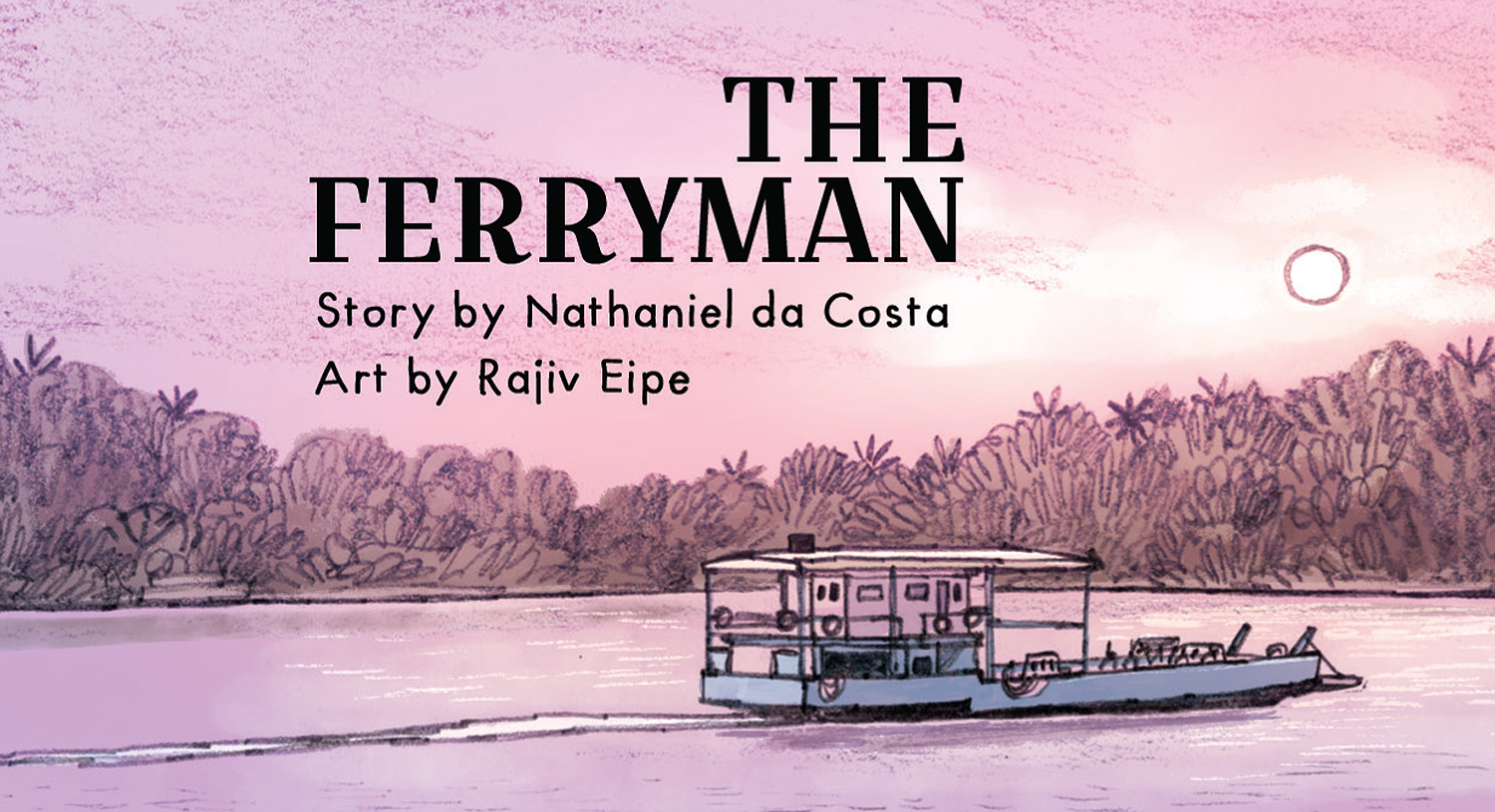
Vol 2 No 4 | Jan-Mar 2023
The Ferryman
Story by Nathaniel da Costa | Art by Rajiv Eipe
‘The Ferryman’ draws its inspiration from characters and cultural traditions based on Greek, Aztec and Christian lore. The idea of a person being the conduit between life, death and the afterlife is explored in multiple different religions and cultures. The Reaper, Mercury, and Charon are all representations of this idea in popular mythology.
Marlon, the ferryman in our story, is a representation of Charon from ancient Greek mythology. According to the Greeks, Charon is the boatman who ferries the souls of the dead across the waters of Hades to the judgment which will determine their final resting place. The Greek Charon as the boatman of the dead is an idea which may well have been influenced by Mesopotamian and Egyptian mythology, where too the Underworld contains rivers that hinder the progress of the soul.
In order to ensure that Charon did actually bother to take the recently-deceased person to Hades in his boat, Greeks buried the dead with a small coin in the mouth to pay the boatman. The coin was typically an obol, and was placed under the tongue. Those souls without the coin were obliged to wait on the shores for 100 years before Charon would condescend to take them across for free. A proper burial was also considered essential to allow the soul to reach Charon’s boat. In later periods, the money tradition changed to placing a coin over each eye of the deceased before burial.
https://www.thoughtco.com/rivers-of-the-greek-underworld
The Day of the Dead and All Souls Day
The entirety of ‘The Ferryman’ takes place during a fictional festival celebrating a day to pray for the dead. The origins of a festival to celebrate the day of the dead is debated, some attributing it to the Aztecs, and taken as a Mexican custom, while some attribute it to the European Christian tradition of celebrating All Soul’s Day.
During the Mexican Día de los Muertos, or Day of the Dead, family members go to graveyards where their loved ones are buried, clean their graves, and decorate them with flowers and food. This is a celebration of life, not mourning the death of a family member. Of course, the most famous aspect of Dia de los Muertos is the calavera, or the sugar skull. Women also paint their faces like La Calavera Catrina, an ‘elegant skull’. That is what has made Día de los Muertos cross over into Halloween territory in the US. Día de los Muertos is celebrated from October 31 to November 2, and is not a sanctioned Catholic observance.
By contrast, All Souls Day is a day that Roman Catholics observe to remember dead loved ones. It isn’t a time for music and dressing up or leaving offerings of food at graves, it is about praying for the souls of the departed who are in purgatory. In the Roman Catholic tradition, even if you are baptised, you die with the guilt of lesser sins on your soul. On November 2, Catholics (such as the ones in Goa, which is visually the setting for this comic) pray for the dead so that their souls can be cleansed and made ready to meet God. Masses for the dead are said and flowers can be placed at their graves, but this day is all about prayers for the dead.
https://kids.nationalgeographic.com/celebrations/article/day-of-the-dead
https://www.thegoan.net/souls-day-reverence-to-departed
Rivers and the Circle of Life
For years, philosophers, priests, poets and writers have looked at the river as a symbol and metaphor for life. A river moves through time and space and the nature of the river—seemingly endless, always in movement—has often been used to describe the eternal flow of time.
There is a mystery about rivers that draws us to them. They seem to rise from hidden places and travel by routes that are not always tomorrow where they might be today. Unlike a lake or sea, a river has a destination and there is something about the certainty with which it travels that makes it very soothing, particularly for those who have lost faith with where they are headed.
Rivers and their use as a way to travel across lands was also commonly used in ancient texts as a metaphor to traverse otherworldly planes. Both the ancient Egyptians and the Greeks used rivers as pathways to the afterlife, and souls had to cross the river or suffer from wandering all through their spirited life amongst the living, a concept that many historians believe is the basis for the Christian concept of purgatory.
https://www.themarginalian.org/2018/05/16/olivia-laing-to-the-river/

